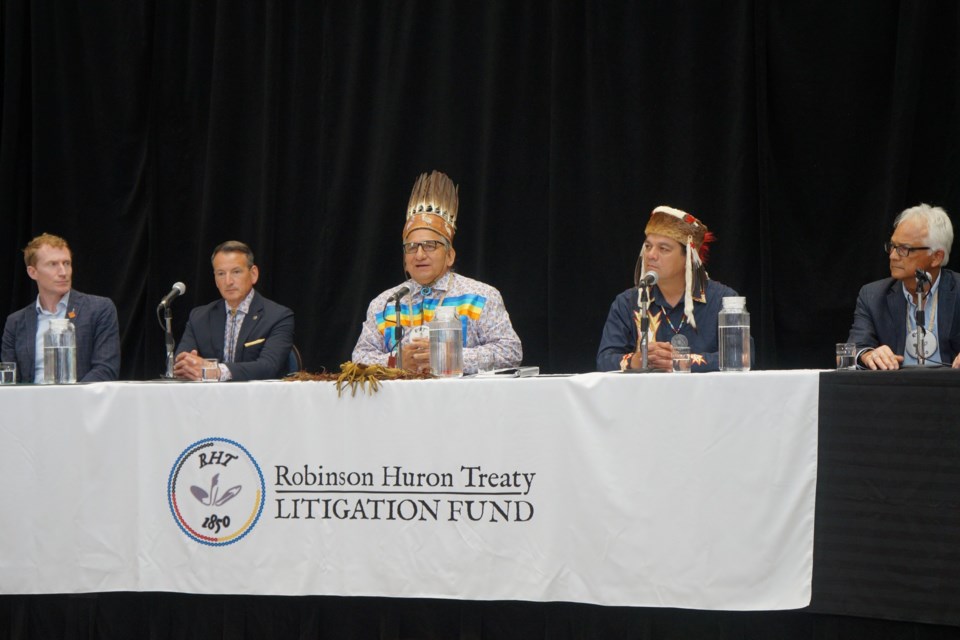The federal and provincial governments have reached a proposed $10 billion settlement with the Robinson Huron Treaty Litigation Fund (RHTLF), representing the 21 Robinson Huron First Nations.
The proposed settlement includes $5 billion from Canada and $5 billion from Ontario to be paid to all 21 First Nations included in the Treaty. The settlement will come in the form of both community and individual investment, to be determined through community consultation.
The announcement was made at Laurentian University’s Indigenous Learning and Sharing Centre on June 17 and began with a private ceremony and the sunrise lighting of a sacred fire. At 1:30 p.m., federal Crown-Indigenous Affairs Minister Marc Miller, provincial Indigenous Affairs Minister Greg Rickford, Batchewana First Nation Chief Dean Sayers, RHTLF Trustee Duke Peltier of Wiikwemkoong Unceded Territory, and Robinson Huron Treaty Litigation team lawyer, David C. Nahwegahbow entered along with elders and the chiefs of each nation.
Hosted by Angela Recollect of Shkagamik-Kwe Health Centre in Sudbury, the press conference began with Grand Entry, an eagle staff leading the way.
The Robinson-Huron Treaty of 1850 Annuities Statement of Claim, which was launched by the RHTLF in 2014, involves a claim for resource revenues. At the time, the settlers of the area were driving economic growth on land that did not belong to them, encroaching on traditional lands. A treaty was signed in 1850.
Under the treaty, the Crown promised to pay a perpetual annuity of £600 ($2,400), which in 1850 worked out to approximately $1.60 per person. But the Crown provided an additional incentive for the Anishnawbek communities to sign the treaty.
Called an ‘augmentation clause', it meant if further wealth was generated in the territory, the Crown was obligated to increase the annuity.
But the annuity was not increased until 1874, despite the economic growth on the land and then, it was only $4 per person. It remains the same today, but could change soon under the new settlement agreement.
The negotiations began in October and required the signing of a negotiation protocol agreement. “This agreement required all discussions and negotiations to be kept confidential. “This confidentiality allows the parties to speak frankly to one another at the negotiating table and has made this proposal possible,” said Sayers. Once the settlement has been signed, and the Superior Court has issued its judgment endorsing the settlement, the RHTLF will move ahead with the next steps in the process.
These steps include moving forward with a community engagement process, including consultations with First Nation members and beneficiaries to provide accurate information about the proposed settlement, said Sayers. These sessions will be led by Harry S. LaForme in the Office of Mizhinawe for the Robinson Huron Treaty First Nations. Based on the information sessions, the Mizhinawe will prepare a report and recommendations for the Robinson Huron Chiefs and Trustees within the next six to eight months.
This proposed settlement is only for ‘past’ compensation compensation up until now. The Crown will continue to distribute $4.00 to beneficiaries until an agreement is reached on the future implementation of the Augmentation Promise. The approach to resource revenue sharing and annuities will be negotiated after the finalization of the past compensation agreement.
The collective nature of the annuity requires portions to be set aside for community development, and to ensure a bright future for the generations to come, said Sayers. “There will also be an individual component to the annuity, and the First Nations will distribute this money to individuals; this amount has not yet been determined,” he said.
The compensation will be distributed to the 21 First Nations according to the terms of a compensation disbursement agreement adopted by First Nations chiefs and councils at the outset of the case, said Sayers. The First Nation councils will be responsible for allocating funds for both community purposes and per capita payments to individuals.
Both Sayers and Peltier thanked the elders and the ancestors for their help and guidance. Sayers said his heart “is much lighter” though there is still work to do.
Peltier said for years the people of the Robinson Huron Treaty nations have been calling on Canada and Ontario to “honour the commitments they made in the Treaty for the last 173 years.”
“Our communities have struggled economically, culturally, socially, because of the breach of Treaty,” he said. “It's our people that have carried the burden of Treaty for far too long. And this compensation from the settlements will ensure a stronger and brighter future for our people, and our nations.”
Sayers called the next steps a new relationship with the newcomers to the land.
“I say newcomers because it's only been a blink of an eye, the last few 100 years that people from around the world have made their way here,” he said. “And it's not been the best relationship. But the Sun has always been shining behind the clouds. The sun has always risen every day and will continue to rise for us in the work that we do today, and for all of the generations in the future.”
For more information, visit the RHTLF website, found here.
Jenny Lamothe is a reporter with Sudbury.com
